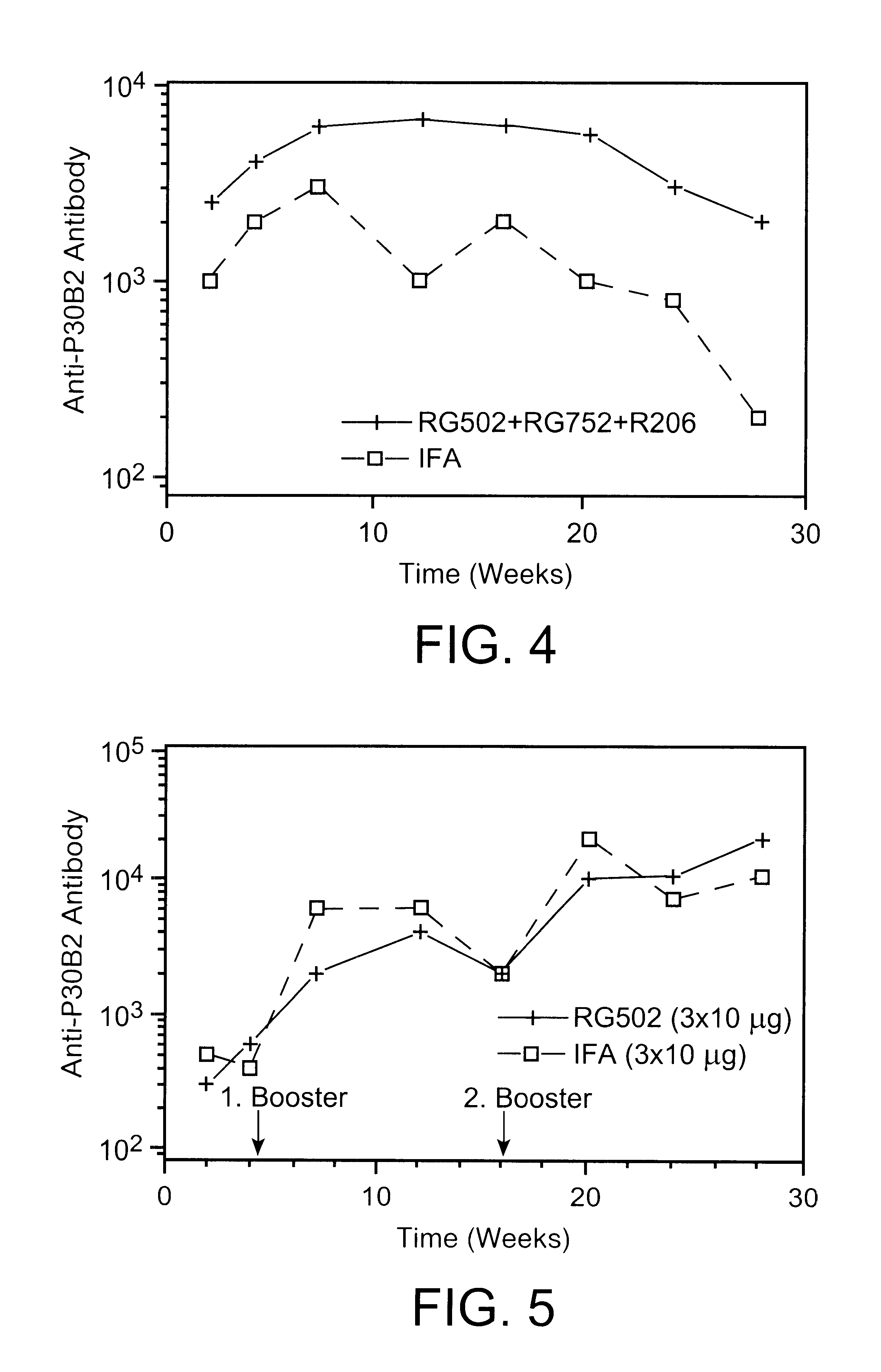Immunological response potentiation process
a technology of immunological response and potentiation process, which is applied in the direction of protozoa antigen ingredients, bacterial antigen ingredients, non-active ingredients of pharmaceuticals, etc., can solve the problems of chemical changes in the components of such liquid-dispersed formulations, not quite harmless toxicologically, and the construct of antigen carrier cells
- Summary
- Abstract
- Description
- Claims
- Application Information
AI Technical Summary
Benefits of technology
Problems solved by technology
Method used
Image
Examples
example 2
describes the potentiation of the antibody response to the branched multiple antigen peptide of the designation P30B2 (in accordance with Example 1), constructed from a universal T.sub.H -cell epitope of the tetanus toxin (sequence 947 to 967) and a B-cell epitope of the repetitive region of the circumsporozoite protein of Plasmodium berghei: 0.02 g P30B2 were dissolved in 2.00 g water and this solution was subsequently dispersed with the aid of an ultrasonic generator in a solution of 2.0 g poly (d, l-lactic acid) (Resomer 206, Boehringer Ingelheim) in 40.0 g dichloromethane. Spherical microparticles (R206) were produced from this dispersion by means of coacervation, induced by the addition of silicon oil. Microparticles loaded with antigen were subsequently suspended in a 5% sterile solution of egg lecithin (Ovothin 170, Lukas Meyer, D-Hamburg) by shaking. This suspension was subcutaneously injected into a group of 8 BALB / c mice in respective amounts of 0.5 ml. The amount of antig...
example 3
describes the potentiation of the antibody response to the branched multiple antigen peptide of the designation P30B2 (in accordance with Example 1), constructed from a universal T.sub.H -cell epitope of the tetanus toxin (sequence 947 to 967) and a B-cell epitope of the repetitive region of the circumsporozoite protein of Plasmodium berghei: analogously to Example 1, P30B2 was incorporated into poly (d, l-lactic acid-co glycolic acid) 75:25 (Resomer RG752, Boehringer Ingelheim) and processed into spherical microparticles (RG752). Microparticles of RG752, RG502 (from example 1) and R206 (from Example 2) containing identical amounts of P30B2 were suspended in a 5% sterile solution of egg lecithin (Ovothin 170, Lukas Meyer, D-Hamburg) by shaking. This suspension was subcutaneously injected into a group of 8 BALB / c mice in respective amounts of 0.5 ml. The amount of antigen injected into each mouse was 30 .mu.g. A second group of 8 BALB / c mice was immunized with the same amount of anti...
example 4
describes the potentiation of the antibody response to the branched multiple antigen peptide of the designation P30B2 (in accordance with Example 1), constructed from a universal T.sub.H -cell epitope of the tetanus toxin (sequence 947 to 967) and a B-cell epitope of the repetitive region of the circumsporozoite protein of Plasmodium berghei: analogously to Example 1, P30B2 was incorporated into poly (d, l-lactic acid-co glycolic acid) 50:50 (Resomer RG502, Boehringer Ingelheim) and processed into spherical microparticles (RG502). The microparticles loaded with antigen were suspended in a 5% sterile solution of egg lecithin (Ovothin 170, Lukas Meyer, D-Hamburg) by shaking. This suspension was subcutaneously injected into a group of 8 BALB / c mice in respective amounts of 0.5 ml. The amount of antigen injected into each mouse was 3.times.10 .mu.g. The injection was repeated after 16 days (first booster) and 113 days (second booster). A second group of 8 BALB / c mice was immunized with ...
PUM
| Property | Measurement | Unit |
|---|---|---|
| size | aaaaa | aaaaa |
| biocompatible | aaaaa | aaaaa |
| antibody titers | aaaaa | aaaaa |
Abstract
Description
Claims
Application Information
 Login to View More
Login to View More - R&D Engineer
- R&D Manager
- IP Professional
- Industry Leading Data Capabilities
- Powerful AI technology
- Patent DNA Extraction
Browse by: Latest US Patents, China's latest patents, Technical Efficacy Thesaurus, Application Domain, Technology Topic, Popular Technical Reports.
© 2024 PatSnap. All rights reserved.Legal|Privacy policy|Modern Slavery Act Transparency Statement|Sitemap|About US| Contact US: help@patsnap.com










